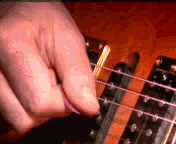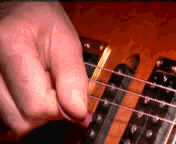| Lesson Subject:
Metallica Style |
| What you learn:
Runs - Part 3 |
| Teacher: Michael Johnson |
Michael:
Metallica changed the way heavy metal/hard rock was played in the late
'80s with their progressive pounding rhythms, lightning fast melodic guitar
licks/runs and growling vocals. Kirk Hammett is the driving force
behind Metallica's dynamic guitar solos and rhythms along with his band mate James
Hatfield who covered most of the heavy rhythms and melodic solos. Kirk's
early influences include the likes of Jimi Hendrix, Led Zeppelin,
& UFO where he eventually developed a sound of his own playing in
early garage bands. Desiring to take his playing to a whole new level, Kirk
sought out the top guitar instructor in the San Francisco bay area, Joe
Satriani who give him the tools to develop some of the hottest heavy
metal solos ever recorded. This lesson will cover standard runs Kurt uses in
some of his Metallica solos, these are crucial to helping you learn how to play fast
Metallica solos and will help you with basics to developing a sound of your own.
Sample some of the runs you'll learn in this lesson:
Michael:
Metallica songs are usually based on the key of E Minor, our first scale is the E minor (Aeolian) scale on the 12th fret:
Michael:
Here's the first jam track.
Michael: This jam track is in the key of E minor also, the notes you might notice in the scale is - E, F#, G, A, B, C, D.
Try playing the scale over the jam track a few times. Here's the tab for the rhythm:
Michael: You can also use the E Dorian mode, it's has one note different from the E Minor:
E, F#, G, A, B, C#, D.
Michael: Notice the difference in this
scale pattern, it's only one note (C#). Now we'll focus on the Metallica style
runs. Try each of these over the jam track. Try learning the tab first, then
gradually increase to the speed of the video.
Michael: This run is an excellent exercise it's actually used in many solos. Notice the run is broken into sets of 4s.
You can count: 1, 2, 3, 4 1, 2, 3, 4 1, 2, 3, 4 etc.
Michael: Your using the same scale pattern, some of you might want to select sections of the interactive tab with your mouse and loop or slow it down.
You can also repeat sections and practice this run over and over to develop your
speed.
Michael: This run still uses the E Dorian mode.
steve: How do you pick those notes?
Michael: Alternate picking.
steve: How do you hold the pick, I mean.
Michael:
I'll show you, notice how I angle the pick slightly, then I pick down then up:


Skedman:
Do you prefer a medium pick?
Michael:
I use a heavy gauge pick by
Dunlop.
steve:
is that what Kirk Hammett uses?
Chris:
Which do you think is better for heavy metal as far as pick thickness
Michael:
I'm not sure what Kirk uses, but I would suggest heavy picks for heavy metal, let's try
the run against a different jam track:
steve: When you're playing fast like that, do you sometimes pick 2 strings at the same time, but deaden one?
Michael: Yes and no, I usually I rest my palm on the upper string to mute it.
The last jam track is good for trying an ascending run using the E Minor Pentatonic scale,
here's the tab for the E Minor Pentatonic scale:
Michael: Notice the E Minor Pentatonic scale is made up of 5 notes, Pen = the word "5",
the notes are: E, G, A, B, D. Let's try the first run using that scale.
Michael: Notice the fingering for the run, the last run is an excellent exercise using the pentatonic pattern.
scotty:
Such a simple graphic pattern--but extremely intense
Michael: It is, you can break portions of the run to create licks,
let's try this run ascending the scale pattern:
Deano:
Doing that last scale 15-15-12-12-15-14, would you barre them in pairs to pick faster?
Michael: You can, I barre two strings at a time for most of the run.
Deano: Ya, Particularly when you're doing the same fret but the next string.
Michael: Here's what the run will sound like using both the ascending and descending
runs:
Michael:
Spend a lot of time on these runs, this will make all the difference in your
playing, believe me, the rewards are well worth it! See you next lesson!
|
<< load notation from left
|